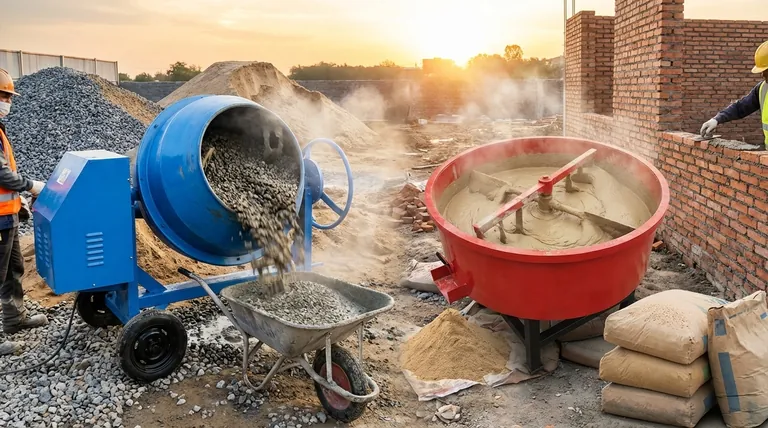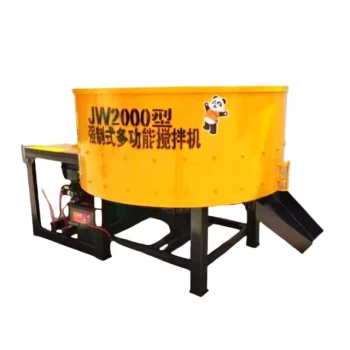Yes, there is a significant and functional difference between a concrete mixer and a mortar mixer. While they both combine cement, aggregate, and water, their mechanical designs are fundamentally distinct. A concrete mixer uses a rotating drum to tumble materials, whereas a mortar mixer uses internal paddles inside a stationary drum to whip them. This core difference dictates which materials each machine can handle safely and effectively.
The essential distinction lies in the mixing action. A concrete mixer is built to tumble heavy materials like gravel, while a mortar mixer is designed to whip lighter, stickier materials like mortar or stucco. Using the wrong machine for the job can result in a poor-quality mix and potentially damage the equipment.

The Fundamental Mechanical Difference
The primary distinction between these two machines is not just their size or power, but how they combine ingredients. This mechanical action is purpose-built for the materials they are intended to mix.
The Concrete Mixer: Rotating Drum
A concrete mixer features a large, rotating barrel, often called a drum. As the drum spins, internal fins lift the materials—including heavy aggregates like stone and gravel—and drop them.
This continuous tumbling and falling motion is crucial for evenly coating every piece of aggregate with cement paste, ensuring a strong, homogenous concrete mix.
The Mortar Mixer: Paddled Tub
A mortar mixer, sometimes called a "paddle mixer," has a stationary tub. Inside this tub, a central shaft with multiple paddles rotates at speed.
This design creates a whipping or churning action, similar to a large-scale kitchen mixer. It is perfect for blending finer materials like sand, cement, and lime into a smooth, sticky, and consistent paste.
Why the Design Dictates the Material
The mechanical action of each mixer is optimized for the specific consistency and components of the final product. Attempting to use the wrong machine leads to inefficiency and poor results.
Handling Heavy Aggregates
Concrete's primary strength comes from its aggregate (gravel and stone). The paddles in a mortar mixer are not designed to handle this weight and size. They would struggle to move the heavy material, strain the motor, and fail to mix it properly.
The tumbling action of a concrete mixer is the only effective way to ensure every piece of heavy aggregate is fully incorporated.
Creating a Smooth, Adhesive Bind
Mortar requires a perfectly uniform, plastic consistency to act as an effective adhesive for bricks, blocks, or stone. The whipping action of a mortar mixer is ideal for this, ensuring there are no dry pockets and developing the desired workability.
While a concrete mixer can mix mortar, it may not achieve the same perfect consistency as a purpose-built paddle mixer.
Differences in Power
Reflecting the different loads they handle, concrete mixers typically have more powerful engines or motors. They need the torque to rotate a heavy, unbalanced load of concrete and stone.
Mortar mixers generally require less power, as they are only blending the comparatively lighter load of sand, cement, and water.
Understanding the Trade-offs and Cross-Compatibility
Knowing when you can substitute one machine for the other is critical for saving time and preventing costly mistakes on a job site.
Can You Mix Mortar in a Concrete Mixer?
Yes. A concrete mixer can effectively mix mortar. The tumbling action is sufficient to combine the sand, cement, and water into a usable product. For small to medium-sized masonry jobs, a standard concrete mixer is a perfectly acceptable tool.
Can You Mix Concrete in a Mortar Mixer?
No, this is strongly discouraged. The paddles are not designed for the size and weight of the stone aggregate used in concrete. Doing so will likely strain or burn out the motor and will fail to produce a properly mixed, structurally sound concrete.
The slurry may not be agitated enough, leading to premature hardening and a weak final product.
Making the Right Choice for Your Job
Selecting the correct mixer is not just about convenience; it's about ensuring the quality and integrity of your work.
- If your primary focus is concrete (slabs, footings, posts): You must use a concrete mixer designed to handle heavy aggregate.
- If your primary focus is masonry (bricklaying, blockwork, stone veneer): A mortar mixer is the ideal tool for creating a consistent, high-quality bond.
- If you do both but can only have one machine: A concrete mixer offers more versatility, as it can handle its intended material and can also be used effectively for mortar.
Ultimately, matching the machine's design to the material's requirements is the key to a successful and durable result.
Summary Table:
| Feature | Concrete Mixer | Mortar Mixer |
|---|---|---|
| Mixing Action | Rotating drum tumbles materials | Stationary tub with whipping paddles |
| Best For | Heavy aggregates (gravel, stone) | Fine materials (sand, cement, lime) |
| Material Output | Homogeneous concrete for structural work | Smooth, adhesive mortar for masonry |
| Power Requirement | Higher (for heavy loads) | Lower (for lighter materials) |
| Cross-Compatibility | Can mix mortar effectively | Not suitable for concrete (risk of damage) |
Need the Right Mixer for Your Construction Project?
Choosing the correct equipment is crucial for the quality and durability of your work. GARLWAY specializes in providing robust and reliable construction machinery, including concrete mixers and mortar mixers, tailored to the needs of construction companies and contractors worldwide.
We offer:
- Durable Concrete Mixers: Ideal for handling heavy aggregates in foundations, slabs, and structural work.
- Efficient Mortar Mixers: Perfect for creating smooth, consistent mortar for bricklaying and masonry.
- Expert Guidance: Help you select the right machine based on your specific project requirements.
Ensure your next project is built to last—contact GARLWAY today for a consultation and discover how our machinery can enhance your efficiency and results!
Visual Guide

Related Products
- Ready Mixer Machine for Construction Ready Mix Machinery
- Commercial Construction Mixer Machine for Soil Cement Mixing Concrete
- Auto Concrete Cement Mixer Machine New
- JDC350 Small Cement Concrete Mortar Mixer
- Construction Products Concrete Plant Machine Mixing Concrete Mixer
People Also Ask
- Can a concrete mixer be used for mortar? Understanding the trade-offs for your project
- Which type of projects require a concrete mixer? Essential Guide for Construction Pros
- What is the average lifespan of a concrete mixer? Maximize Your Equipment's Lifespan & ROI
- What safety considerations are important for concrete mixer operation? A Guide to Proactive Risk Management
- What was significant about Roscoe Lee's 1934 concrete mixer design? Pioneering Modular Construction Equipment



















